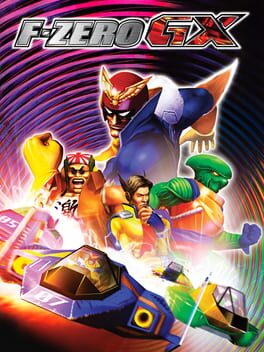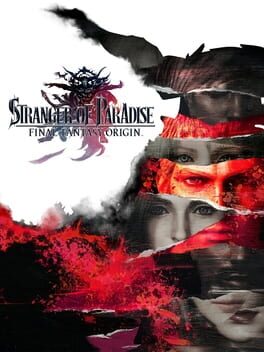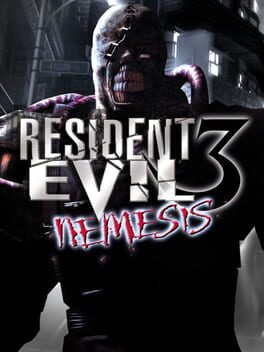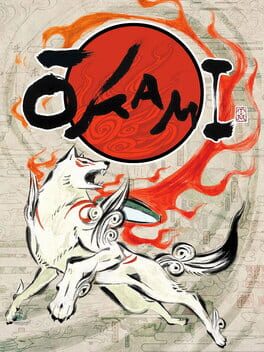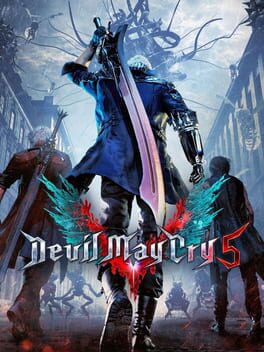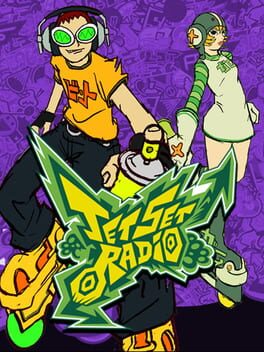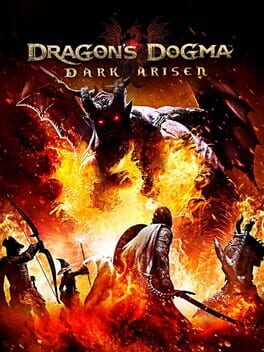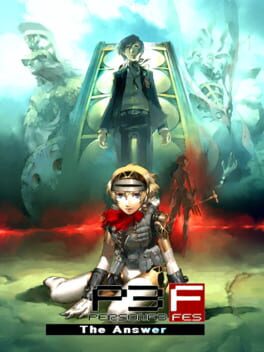sleepytitan
Black queer menace that loves survival horror and action games, rpgs, and metroidvanias.
Don't take my ratings too seriously but here's a breakdown:
5: The best to me and my most adored games of the medium.
4.5: Nearly peerless but is held back by one or two things but are still exceptional.
4: Pretty good games with some glaring problems to me.
3 and 3.5: Fine games that don't do much for me but I still find enjoyment in them.
2 and 2.5: Very mixed to negative/poor, but definitely not the worst.
1.5 and below: Awful, trash, painful.
Top 5 will probably remain consistent.
Badges

Trend Setter
Gained 50+ followers

Adored
Gained 300+ total review likes

1 Years of Service
Being part of the Backloggd community for 1 year

GOTY '23
Participated in the 2023 Game of the Year Event

Roadtrip
Voted for at least 3 features on the roadmap

Popular
Gained 15+ followers

Loved
Gained 100+ total review likes

On Schedule
Journaled games once a day for a week straight

Organized
Created a list folder with 5+ lists

Pinged
Mentioned by another user

Listed
Created 10+ public lists

Gone Gold
Received 5+ likes on a review while featured on the front page

Well Written
Gained 10+ likes on a single review

Gamer
Played 250+ games

Best Friends
Become mutual friends with at least 3 others

Donor
Liked 50+ reviews / lists

Liked
Gained 10+ total review likes

Noticed
Gained 3+ followers

N00b
Played 100+ games

GOTY '22
Participated in the 2022 Game of the Year Event
Favorite Games
372
Total Games Played
008
Played in 2024
065
Games Backloggd
Recently Played See More
Recently Reviewed See More
This review contains spoilers
A part of me does feel more could have been done in maintaining the original's resistance within the battling/dungeon traversal as the difficulty suffers quite a lot halfway through, even with Merciless being leagues better and actually operative compared to persona 5's version. As one of ten fans of the original Tartarus, reload's iteration is absolutely beautiful and doubles down to be more gamey and 'addictive' but it does sacrifice the tension and threats of the enemies with the changes to the landscape and battles. The Theurgies are a wonderful treat of power fantasy and spectacle while also adding more interesting dynamics to each member's kit, but I feel that they could have been restricted or handled more conservatively, even if I do enjoy breaking this game in half.
While reload does deliver the darker tone of the original, it's not perfect in translating the dread and oppression well throughout the journey, though this was most apparent to me in specific cutscenes. Take the original and reload's introduction on the train; they follow mostly the same structure but the new animation and direction lacks the bite and visceral feel, specifically in how the original juxtaposes Makoto ominously arriving on the train with Yukari's struggle to summon her persona while Burn my Dread blairs jaggedly and cuts in and out of the scenes. Reload didn't have to replicate this but the new intro feels more standard-fare and less haunting and off-putting, even Makoto's awakening scene falls into this same issue by following the same beats of the original but the transformation of Orpheus into Thanatos ends up being a bit goofy? The cast overall is a dimension friendlier than the original, but I'm not sure this is more due to nuances in the voice direction of the new cast or slight changes in the script, though I feel it is more the former. Still, reload does a solid job with the rest of the cutscenes in the games outside of one of the final animated scenes showing Makoto returning after sealing Nyx. Even some reload iterations I found a bit more memorable than before such as Chidori's sacrifice and Junpai's second persona awakening and Shinji's death (outside of Koromaru low key ruining it with his howling at the end). It's not a complete loss in atmosphere as January itself still encapsulates the impending doom of the fall very well, alongside just turning down the brightness like two-three notches in the options.
Even with the strong effort reload is in delivering persona 3 to the 'masses', it still doesn't strike as a "definitive" version of it, which I think is way better than an end-all-be-all edition ever existing given the small and major differences and interpretations baked into each version at this point. Reload is probably the second best way of experiencing persona 3 as I still would encourage people to play FES if they can. The whole idea of it being "outdated" is categorically false and it still offers so much in its tone and gameplay that reload drastically differs or falters from in many ways. Even still, reload is a wonderful way to experience the best persona game and the 150+ hours I put in on Hard and Merciless have been well worth the return back to Tatsumi Port Island.
And since the remake train has pretty much started with this series now, I should probably run and get a head start on Persona 1 and 2 before those new remakes come out at some point while Persona 6 and its re-released special green edition sits in a cobweb somewhere in the Atlus studios.
This review contains spoilers
Dragon's Dogma II holds the same essence twelve years later on that defined its predecessor and took me by surprise with how compelling and unique I found the overall experience to be for an open world (action) rpg. Exploring the new world is thriving both on foot and on the new ox carts while sitting back and taking in the quiet and dense scenery until an ogre or another presence interrupts the tranquility, even with the threat of destroying the cart and forcing the trek back on foot. Camping and the loss gauge are fresh additions that add up the attrition of the adventure and channel the tension that is baked in to its core design. The pawns themselves are as strange as they were before and still manage to surprise me with all that they can do and lead me to through the open world.
The open world was a slight concern given the bigger size and presence of two nations (Vermund and Battahl) this time around, despite Gransys being a memorable locale ignoring the recycled enemies and lacking diverse environmental and town detail. Vermund itself feels like Gransys with even more of a budget and careful hand behind it with a sizable number of hidden platforming parts and uneven flourishes to drive careful travel and ambush opportunities for enemies or the party. What's striking is the amount of verticality and elevation pumped in with lots of cliffs, mountains, gorges and so many damn bridges decorating the landscape, not just inviting curiosity of what's there but in adding subtle tension and strategy with enemy encounters. This might have been just a me thing, but I felt anxious in encounters where these possibilities were so clear and the consequences even more perilous if I was already struggling to get to a safe spot nearby. Interesting standoffs aren’t the only star of the show as the world contains a balanced amount of points of interest that either I or my pawns noticed and diverted me from the main path towards. While mileage may depend on what the discoveries amount to, the world design feels paced well with a good amount of interesting pathways and rewards, along with the randomness that prevents progressing and backtracking from becoming a mindless chore of running forward for x amount of time to reach a town or space. I still desire for way more towns to scale and run around in as they are still few and far between, though with the performance issues in Vernworth it might be for the best.
While the sequel does great work in making the world feel interesting and alive, the exploration and magic of it all doesn’t hide the more glaring problems present as the hours drag on. What makes DDII fall short for me is this whole feeling of unfinishedness that seeps throughout the experience, even though much discussion of this game revolved around it finally executing the vision that the original didn’t meet because of how rushed it was like the main narrative. The first game's main campaign was very short and forgettable that a part of me wondered if the sequel would add more meat and grip this time around. It has a promising start unraveling the conspiracy at the capital surrounding the Arisen, but falls victim to being front loaded with run of the mill main quests, and the pacing and intrigue of the plot falls to the wayside a good amount through Battahl and doesn’t really recover going forward. The side quests and the paths to discover and complete them are once again the more intriguing part of the journey where I was thoroughly invested in DD2's world, but it’s a weird blemish considering the first game’s attempt and the sequel’s gesturing towards something grander, even in the interviews from Itsuno and other developers themselves! It almost feels intentional. Even the beloved system is still as underdeveloped and aggressively heterosexual as before and you can only romance two women who aren’t given a ton of screen time in the story.
Enemy variety is somehow still dull as the first but the density exacerbates it to be in a way worse form than originally. Given the scale of the world, enemies are sprinkled absolutely everywhere with very little change across regions and it becomes tedious and grating with how much it interrupts the world traversal for another squad of goblins, another ogre, another set of wolves, another group of bandits, another… While the combat itself saves them from becoming full on monotonous trash mobs, the lack of escalating challenge and diversity of foes (color swapping enemies doesn’t fare much difference) doesn’t alleviate the issue. Even the more rare foes feel less visceral; I was taken aback by how “normal” the first encounters with the drakes and Medusa were that I thought I did something wrong…but at least there's dungeons to look forward to?
DD1 didn't sport the most amazing set of dungeons but I can recall a handful of memorable ones based on story reasons but also the light puzzle elements with the combat in making the spaces like the catacombs feel important in the world. DD2 isn’t without a few that host unique interactions like Dragonsbreath Tower, but across the board it somehow messes this up with a lack of meaty dungeons to dive into, and instead there are like 50+ caves seemingly copy and pasted with very similar, rote layouts, rewards and enemies. This has been driving me mad especially since so much care has went into crafting the outer lands, but these spaces feels so lacking and substance-less for no reason other than to possible fill in more space. Did the budget and time run out here or was there not much of a mind to do them this time around?
Much of the discourse around this game, outside of the tacked on MTX, is the frictional nature that DD2 drenches itself in and commits to. It doesn’t feel too uncommon from the reactions to Armored Core VI last year on release despite the legacy of FromSoft and their game philosophies, but worthless MTX has made it even more insufferable and disingenuous to sift through. A part of me is glad that something like DD2 exists and is pretty popular despite the blowback to making features feel less mindless than the standard fare in other AAA titles. On the other hand, I feel that this game could have went even harder than it actually is when it comes to “friction” everyone talks about. It manifests mostly in the open world traversal and how quests are achieved and play out, but generally it doesn’t go hard enough without an additional higher level difficulty option being available, which I guess will come later down the road at some point but I’m just left with a lot of questions.
Dragon's Dogma II is such a strange experience going in with the first one impressing me so much even with much being left on the cutting room floor. I'm not as miffed as others are about this, and yet I can't but feel a little disappointed with what's here despite still enjoying the main gameplay loop outside of the main story. The microtransactions become such a small issue when staring down at the more structural problems that are actually hard to ignore in DD2 and drag down the experience. 12 years later and Dragon’s Dogma still feels haunted by the spector of missed potential of a grander journey that it suggests but hasn’t really accomplished, and I suppose some expansion will be a thing at some point to address that but it’s just so tired. There's still so much I love here and will be coming back to, but I can't really kick the "that's it?" feeling at this point with this game that’s been in the making for quite awhile. Weirdly leaves me feeling like how I felt about Tears of the Kingdom last year, but I don't feel cold on DD2, at least yet.
The gameplay is so enthralling, and the influence of various games like Devil May Cry and Monster Hunter feel so familiar in the moment to moment action while still being its own thing. The starting vocations are pretty standard fare but open up to even more interesting advanced classes like a mystic knight and magick archer that mix two divergent classes in a shockingly satisfying way. I chose strider as my starter because of my love for quick, high octane action with a lot of movement variety, and found myself falling so comfortably into this role for a long while. It’s so seamless going back and forth between being a mid/long distance archer and then facing off in the frontlines in melee with daggers. Also adding to the experience are passive abilities within the class and others that crafted my unique build and kept progression interesting throughout the game; the other vocations feel just as exciting, fleshed out and varied from one another while still being integral to encounters. Even with my time being focused in melee combat through the strider/fighter/assassin vocations, I dedicated some time to being a sorcerer to set up a potential build for the magick archer and mystic knight and it was still such a blast being in this alternate role wiping off foes with miasma, fire and necromancy. What’s here is unique and satisfying in a way I struggle to find in many other action RPGs and it’s no surprise it comes from the mind of Hideaki Itsuno and the other developers at Capcom that worked on DMC and other titles that make the action feel in sync with the RPG mechanics without one or the other being siloed.
What further sets Dragon’s Dogma apart from many others in the genre is how interactive it is with giant monster encounters and how open it is to player freedom. The prologue smartly showcases the mechanical depth of these encounters in a final battle with the chimera. The chimera can be scaled by grabbing and climbing onto it, and specific parts can be damaged or torn off to weaken it such as the snake tail to stop poisonous attacks or the goat head to stop spell casting. Additionally, the chimera has elemental weaknesses that can be exploited by the mage/sorcerer or by picking up and throwing nearby explosive objects; other actions can be part of your play like dousing it in oil and setting it on fire, kicking it off edges if present, freezing it, stunning it, and various other means. These aspects carry on to other giant creatures like the cyclops, drakes, and griffins and they make battles feel very dynamic and fresh like Monster Hunter does with its own giant monsters. Scaling a cyclops blew me away the first time I did it because this kind of option was supported in fighting big enemies rather than being restricted to one part to whittle down or even having to ‘stagger’ them before pulling off cool moves, not to mention actually seeing enemies react to getting hit in specific ways rather than getting no feedback at all. It just feels so good having these avenues available and consciously being thought of by the developers.
The pawn system is possibly the most enticing hook of Dragon’s Dogma when first experiencing this game. It’s strange in a similar manner to the social, online features and interactions ushered in the Souls games through notes and bloodstains left in specific areas to give context to the space. The pawns are similarly a creation of other players with their knowledge and decisions wrapped up in them. They make encounters and excursions even more interesting based on not just their class/stats but also the quirks and characteristics they inherit from their Arisen such as staying long distance in battles or even confronting foes head on. It is fascinating how much influence the pawns take from the Arisen’s lived experience and the battles and quests checked off in the journey, and how remarkable the AI acts for the most part in tackling creatures or leading you to certain locations in quests based on their previous knowledge. It’s a job well done seeing my main pawn stand down against the enemy aggressively and call out to target specific parts as they took away from my previous actions of climbing and attacking a past creature.
I was also vastly surprised with how much I actually enjoyed the mechanic of weight and encumbrance for my character. The amount of stuff you carry on your person matters here and character creation even adapts this through the height and weight you select. The encumbrance of your character affects how fast they move and their stamina recovery rate. You can change this through running back to storage at save points to dump items, but also allocating materials between pawns. as well. It’s a similar play to Resident Evil in managing inventory and weighing decisions of whether you want to bring specific materials with you or not and how it affects your own character's movement in the world and battles, though a bit less tense than classic Resident Evil’s inventory management.
The open world of Gransys and its cities and dungeons are fulfilling with getting the sense of adventure across. Though unfortunately very few, the cities of Cassardis and Gran Soren feel alive and offer a good amount of rewards and secrets through exploring and platforming. This extends outside the cities and into the open fields, forests, and caverns in Gransys with a small number of landmarks overall but still impactful in their own right. The few caves in the game feel wholly unique from one another and involve different ways of traversing them with specific creatures appearing; the Soulflayer Canyon plays on verticality very well and pairs a cyclops on a small rock crossing over a cascading ravine that could mean you or your pawn's death or even the creature’s by knocking them off of it. Past this encounter are several pathways through water sliding that lead to valuable loot, rewarding you for that earlier encounter while also leading back to the main path of the cave to continue traveling. While it would have been cool to have some element of environmental storytelling in some spaces to fill in the emptiness, what’s here feels rewarding and meaningful with explicit choices that showcase the fun level design of specific caverns and forests and have benefits to clearing them out and even returning with chests respawning after a time.
I touched on tension earlier when talking about encumbrance and management, but this comes into play heavily in traversing the open world and its day-night cycle that shakes up the exploration. There’s various paths to follow that lead to major places around the region and they lead you there in mostly the safest way possibly, even the pawns themselves state that straying from the designated path could spell danger and this is very real for quite awhile in the game. Gransys isn’t overwhelming large, but the slow traversal and lack of fast travel options until later through portcrtystals gets that feeling across, next to the enemies you encounter by going off the beaten path, especially at night. Encountering an ogre during the nighttime in the open fields as a low level Arisen scared the shit out of me as I spammed for my pawns to run away with me, but I eventually came to love nighttime traversal as I got stronger and faced down with what awaits during the night, even with the pitch black landscape setting the ominous atmosphere.
The quests are the only aspect where I take some issue. Most of them, including the main quests, are pretty simple from a gameplay perspective and the stories and characters within are pretty alright and do their thing for the runtime, even with their signature speech style. The affinity system is similarly underdeveloped and obscure that I almost forgot about it until a pivotal story moment where the main villain steals a special person to the Arisen that surprised me with what the game chose for me since I didn't care much for anyone. The main traversal can be an tedious for some since the only way of getting across Gransys is by foot outside of placing portcrystals in specific spots for fast travel and using a limited number of ferry stones (or just using the eternal ferry stone in this version of the game), but I didn’t mind this much over other aspects. The half-baked nature could also be applied to the world and enemy variety, though I do feel what they have in the final game, with even more in the post game and Bitterblack Isle expansion, still manages to be fulfilling and interesting unlike the majority of the quest design and characters. I can’t fault these issues too much on the developers as these probably came from development and budgetary constraints and the higher ups wanting to get the game out there.
Even with the complaints, I do appreciate how the main quests don’t railroad you towards a specific path or limit exploring certain areas until you get to a specific quest that adds context and availability outside of one or two “end game” areas that make sense. The forgery mechanic comes into play in great and hilarious ways with certain quests such as being tasked with recovering a special ring for the Duke and giving back fake copy to keep the real one for stat bonuses; the developers even go out of their way to construct scenes and situations for this like with the aforementioned one showing the king try to open a chest with the fake ring but failing to do so, giving you the opportunity to sneak in the castle at night and take the reward in the chest yourself with the real ring in hand. Also thankfully, there are not a huge amount of side quests here and they are even missable too though specific choices you make during the game, something I feel many games and open world games in particular today shy away from for the player to know everything and all in the first play through. Even with the rote quests, they still offer an element of fun in the freedom found in some and the interesting lore that comes from completing the quests that further unravel the mysteries surrounding pawns, Gransys, the Arisen and many other details in the world. The Bitterblack Isle and postgame complements the lore of Dragon’s Dogma so well, but I’m still progressing through it as I write this.
Dragon’s Dogma 2 looks to be my most anticipated game releasing this year and in two months I cannot wait to unravel what the new world has in store. Even with this bigger budget and possibly even more ambitious sequel coming out, the original Dragon’s Dogma still and will continue to hold a special place for me in these months leading up to and beyond the sequel’s release in future new game plus runs and combing through more of the expansion. Maybe Action RPGs aren’t done with surprising me in great ways.
